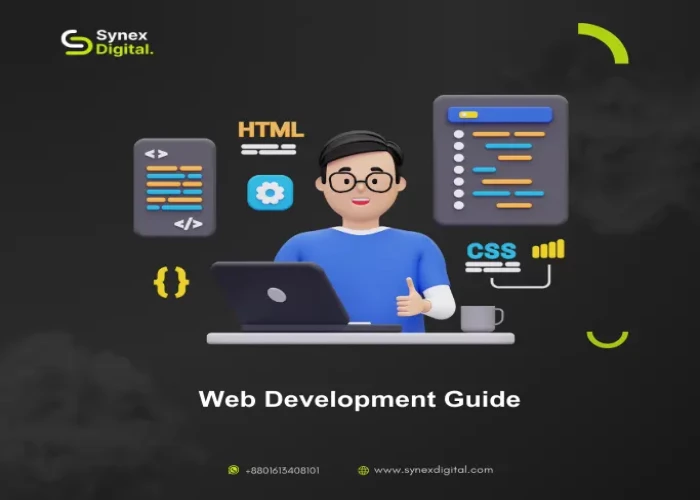In today's digital age, web development plays a crucial role in shaping the online world. Websites have become the face of businesses, organizations, and individuals, serving as the gateway to information, products, and services. But have you ever wondered what goes into creating these websites and how they power the internet? In this ultimate guide, we will delve into the world of web development, exploring its importance, the different types of development, key skills and languages, the web development process, and much more.
Web development is the backbone of the internet. It encompasses a wide range of activities involved in building and maintaining websites. Without web development, the internet would be a static and lifeless place, devoid of interactive experiences and dynamic functionalities. Whether it's a simple blog or a complex e-commerce platform, web development brings websites to life, making them visually appealing, user-friendly, and responsive across different devices.
Moreover, web development is not limited to creating websites. It also involves optimizing them for search engines, ensuring they are accessible to all users, and integrating various third-party tools and services. In essence, web development empowers businesses to establish a strong online presence, engage with their target audience, and drive growth in the digital landscape.
Front-end vs. Back-end Development
Web development can be broadly categorized into two main areas: front-end development and back-end development. Front-end development focuses on the visual and interactive aspects of a website that users see and interact with. It involves writing code in HTML, CSS, and JavaScript to create the layout, design, and functionality of the user interface.
On the other hand, back-end development deals with the behind-the-scenes work that powers the website. It involves writing code in languages like PHP, Python, or Ruby to handle data storage, server communication, and application logic. Back-end developers work on databases, server configurations, and APIs to ensure smooth functioning and data processing.
Key Skills and Languages Used in Web Development
To excel in web development, there are several key skills and languages that developers need to master. HTML (Hypertext Markup Language) forms the foundation of web development, defining the structure and content of web pages. CSS (Cascading Style Sheets) is responsible for the visual styling and layout of websites, while JavaScript brings interactivity and dynamic functionality to the forefront.
In addition to these fundamental languages, web developers often work with frameworks and libraries that streamline development and enhance efficiency. Popular front-end frameworks include Bootstrap and React, while back-end frameworks like Node.js and Django are widely used. Knowledge of databases, such as MySQL or MongoDB, is also essential for storing and retrieving data.
Furthermore, a successful web developer possesses problem-solving skills, attention to detail, and the ability to adapt to new technologies and trends. Continuous learning and staying up-to-date with the latest industry practices are crucial in this ever-evolving field.
The Web Development Process
Creating a website involves a systematic process that ensures a smooth and successful development journey. The web development process typically starts with gathering requirements and understanding the client's needs. This is followed by planning and designing the website's structure, wireframing, and prototyping.
Once the design is finalized, the development phase begins, where the actual coding and implementation take place. Front-end developers bring the design to life by writing HTML, CSS, and JavaScript code, while back-end developers handle server-side programming, database integration, and functionality implementation.
After development, thorough testing and debugging are performed to ensure the website is free of errors and functions as intended. Once the website passes all quality assurance checks, it is ready for deployment, where it is made available to users on the internet. Post-launch, regular maintenance and updates are carried out to keep the website secure, performant, and up-to-date.
Different Types of Websites and Their Development Requirements
Websites come in various shapes and sizes, each serving a unique purpose and catering to specific needs. Some common types of websites include:
Static Websites: These websites are simple and consist of fixed content that rarely changes. They are typically built using HTML and CSS and are suitable for informational purposes.
Dynamic Websites: Dynamic websites are more interactive and content-driven. They are built using server-side languages like PHP or Python and often rely on databases to store and retrieve data.
E-commerce Websites: E-commerce websites allow businesses to sell products or services online. They require complex functionality for product listings, shopping carts, payment gateways, and inventory management.
Content Management Systems (CMS): CMS websites enable users to create, manage, and publish digital content easily. Popular CMS platforms include WordPress, Joomla, and Drupal.
Web Applications: Web applications are complex and feature-rich websites that perform specific functions or offer services. They require extensive development using frameworks, APIs, and databases.
Each type of website has its own development requirements, and web developers need to adapt their skills and approaches accordingly.
The Role of Web Developers in Creating User-Friendly and Responsive Websites
Web developers are the architects and builders of the digital world. They play a crucial role in creating user-friendly and responsive websites that provide seamless experiences across different devices and platforms. Web developers work closely with designers to translate visual concepts into functional code, ensuring that the website's design is optimized for performance and usability.
They utilize their knowledge of front-end and back-end development to implement interactive features, optimize loading times, and ensure compatibility across different browsers. Web developers also prioritize accessibility, making websites usable for people with disabilities, and ensuring compliance with accessibility standards.
Moreover, web developers are responsible for implementing responsive design, which allows websites to adapt and provide optimal experiences on various screen sizes. This involves utilizing CSS media queries, flexible layouts, and fluid grids to ensure that websites look and function well on desktops, laptops, tablets, and mobile devices.
Trends and Innovations in Web Development
Web development is a continuously evolving field, with new trends and innovations emerging regularly. Staying up-to-date with these trends is essential for web developers to create modern and cutting-edge websites. Some current trends in web development include:
Progressive Web Applications (PWA): PWAs combine the best of web and native applications, providing an app-like experience through web browsers. They offer offline capabilities, push notifications, and fast loading times.
Single Page Applications (SPA): SPAs load content dynamically, eliminating the need for page refreshes. They provide seamless and fluid user experiences, often incorporating frameworks like React or Angular.
Artificial Intelligence (AI): AI is being integrated into web development to enhance user experiences, personalize content, and automate repetitive tasks. Chatbots, voice assistants, and recommendation systems are some examples of AI-powered web applications.
Motion UI and Microinteractions: Motion UI and microinteractions add subtle animations and transitions to websites, making them visually engaging and interactive. They improve user engagement and provide a delightful browsing experience.
Web developers need to stay abreast of these trends and incorporate them into their projects to create websites that meet the expectations of modern users.
Web Development Tools and Resources
The field of web development is supported by a wide range of tools and resources that streamline the development process and enhance productivity. These tools include integrated development environments (IDEs), code editors, version control systems, and collaboration platforms.
Some popular web development tools and resources include:
Visual Studio Code: A lightweight and powerful code editor with extensive customization options and support for various programming languages.
GitHub: A version control system that allows developers to collaborate and manage code repositories effectively.
Bootstrap: A front-end framework that provides pre-built components and styles to simplify website development and ensure responsiveness.
Stack Overflow: An online community where developers can ask questions, seek solutions, and learn from the experiences of others.
W3Schools: A comprehensive online resource that provides tutorials, references, and examples for web development languages and technologies.
These tools and resources empower web developers to work efficiently, solve problems, and stay connected with the developer community.
Conclusion: The Future of Web Development and Its Impact on the Internet
Web development is a thriving industry that continues to shape the online landscape. As technology advances and user expectations evolve, the future of web development holds exciting possibilities. From the integration of artificial intelligence to the proliferation of mobile devices, web developers will need to adapt and innovate to meet the demands of a digitally driven world.
The impact of web development on the internet cannot be overstated. It enables businesses to reach a global audience, facilitates communication and collaboration, and provides access to information and services at our fingertips. As web development continues to evolve, it will play an even more significant role in connecting people, creating immersive experiences, and driving the digital economy forward.
Whether you aspire to become a web developer or are simply curious about the inner workings of the internet, understanding web development is essential in today's interconnected world. By unraveling the mysteries of web development, you gain a deeper appreciation for the websites you visit and the technology that powers them.


